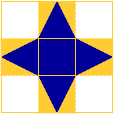We went out to Welshpool today to the warehouse where the major portion of the Western Australian Museum's various collections is stored. The reason for our visit was to see a Papuan dance mask that Kevin donated to the museum in 1962. It has been in storage almost all the time since.
While there we were shown a number of different PNG artifacts including some tapa from Oro Province. When we were living in Popondetta in the 70's I used to buy tapa from the women who made it. I did this on behalf of the Vocational Centre where I taught. The centre ran a small business and tapa was made into hats and bags or sold by the piece to tourists. The photo is of a piece of tapa that I bought for myself at that time.

Tapa is made from the bark of a species of mulberry. The pieces of stripped bark are beaten out over a log until they are flexible. Some pieces of tapa are huge, this one is quite small - about a metre by 60 cm. The very best tapa is as flexible as cloth with almost no holes. Thicker tapa with no holes is generally not as highly regarded as thinner tapa with holes, but even the best quality tapa must be decorated well to be valuable. Traditionally, the red in the designs is made from hibiscus gum, the black from charcoal. In the 70's these were painted on with brushes made from chewed twigs. Designs are usually based on natural objects - fish, lizards, palm fronds, but may also be purely geometric.
Tapa from some of the Pacific islands is varnished but PNG tapa is soft. It was used for all the things cloth is - wrappings for gifts, food and as shrouds, clothing, curtains, table and bed covers. I believe tapa is still being made but woven cloth has replaced it for everyday use.
The tapa I saw at the Museum was not the best quality and the painting was very poorly done. The line surrounding the red motifs was very definite, unlike the the soft lines and dots of the tapa I am accustomed to. It looked to be the work of a beginner or someone unaware of the traditional styles. The pic below shows the design outlines of a traditional piece very clearly.

PS: I walked 11023 steps yesterday. I have 9433 on the pedometer at the moment and I still have to prepare dinner.






